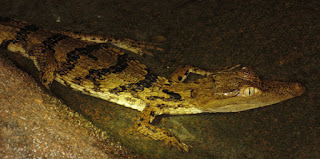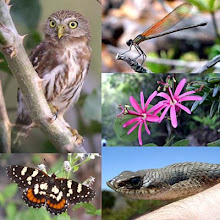August 20,
2015
This morning
was our turn at Tower II, the 53-meter tall canopy tower across the river.
Activity wasn’t bad, and we had distant views of a Pompadour Cotinga, mostly
just in flight, as one highlight. A very close Southern Scrub-Flycatcher and a
Layard’s Woodcreeper (recently split from Lineated) were also memorable. The
only photo I took worth keeping though was this Spangled Cotinga.
On the way
back we birded a forest trail that was very quiet, but a highlight for me was
spotting this Snow-capped Manakin nest. Notice the white Rhizomorpha fungus it
incorporated with plant and moss fibers. Many species of birds use this fungus
for some reason, and Bare-necked Fruitcrow apparently makes its nest solely
from it.
Back at the
lodge for lunch and afternoon break, I found that the Uroderma sp. tent-making bats had returned, making a new nest in
the Phenakospermum stand by the old kitchen. Yesterday I failed to find them
noticing that one of the staff had cut down the leaves they were using two
weeks ago. I made a point this evening of letting the manager, owner, and at
least a couple staff know that cutting these plants was a no-no.
Of course,
the Saccopteryx bilineata, White-lined
Sac-winged Bats were reliably under their undisturbed eves of the leaders’
dorm.
Puddle party
action by the boat dock continues with lots of pierids but not many
swallowtails or skippers, but this Baeotus
aeilus, Amazon Beauty, did at least provide some relief from the yellows
and whites.
Yesterday
afternoon and much of today Fabrice and I were annoyed by the noises made from
a nesting pair of Palm Tanagers on our roof, right by the screen that is
supposed to allow accumulating heat below the ceiling to escape. Just as we
were preparing to head out for the afternoon I noticed how unusually loud the
insistent begging was from one of the chicks, and then I noticed it next to my
bed and my tangle of recharging cables. It had been there for a while, leaving
quite a mess. Considering Palm Tanager rather a weed among birds, I didn’t feel
the need to give it any special attention, so I just left it under the palm
shrub in the shade outside our room, expecting that its begging shrieks would
eventually attract the feeding urges of the parents.
On my
afternoon outing I took my group to the Manakin Trail through igapó forest, a seasonally flooded
forest that has very well-drained soil and therefore has a very open understory
and doesn’t remain muddy (unlike várzea in
much of the Amazon basin). On the trail we saw few birds, but a noisy family of
Red-throated Caracaras did entertain us and allow close approach.
The trail
ends in a low sump that still had some water, indicating it had been an
unusually wet and long rainy season (we are near the end of the dry season now,
and in most years past this site has been totally dry by this date). We approached
the pond very quietly but still caught only glimpses of a very shy Sunbittern
that disappeared into the forest. But our sneaking did pay off with fabulous
views of a White-throated Tinamou that came up for a drink just as we were
arriving. I have heard this species a few times at Cristalino but this was the
first time I’d seen one. I didn’t manage any photos, but I noticed the white
speckling in plumage, a clinching field mark. After it left, we came out into the open next to the pond and watched the canopy and undergrowth for anything coming in for a drink. We did see Dot-backed Antbird bathing, and a Long-billed Woodcreeper came into the trees overhead.
This evening
after diner I offered to take people down to the rocks to see what fish and
other critters we could spot. One was this young Caiman crocodilus, Spectacled Caiman, which we could have caught.
There are
many species of armored catfish here, but they are difficult to photograph and
almost impossible to identify. This is in the family Loricariidae.
This Fredius reflexifrons freshwater crab was
fully out of the water to feed on something on the rocks.
There are
tiny freshwater shrimp if you look closely.
I turned
over a small rock to find this ghastly larva, probably a dobsonfly.
On the way
back to the rooms I flushed this Pristimantis
sp., a frog formerly in the huge genus Eleutherodactylus.
This species wasn’t identified by the herp survey that took place here more
than a decade ago and could be an undescribed species for all I know.
Meanwhile at
the moth sheet, where I took dozens of photographs, here are some highlights:
Pseudautomeris sp., a saturniid silk
moth. I had never seen this one before and did a thorough search of Automeris species before I finally found
the correct genus; I still don’t know the species.
Idalus sp., an arctiine moth
a wasp-mimic
arctiine moth, possibly a Cosmosoma sp.
Eulepidotis cf. persimilis.
a geometrid
moth, an emerald in the subfamily Geometrinae
and a
probable geometrid moth that was totally new to me.

























No comments:
Post a Comment